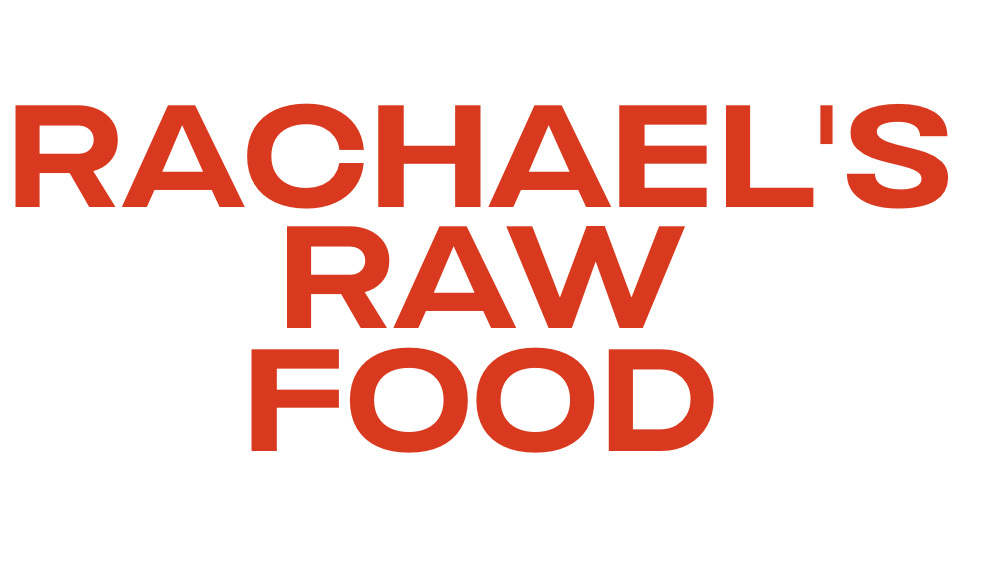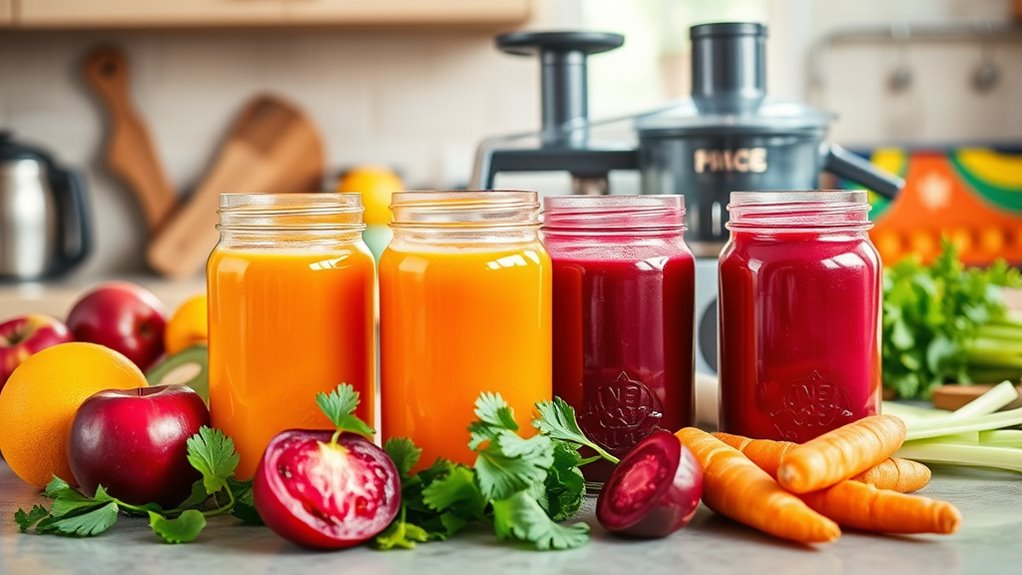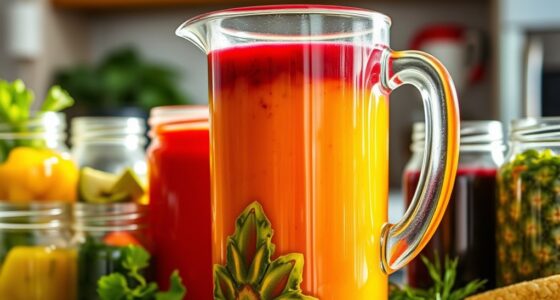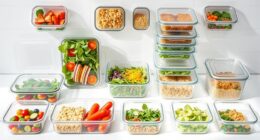To save money while juicing daily, plan your ingredients ahead and buy in bulk, focusing on seasonal or frozen produce for freshness and affordability. Use versatile gadgets like a high-quality juicer or blender to get the most nutrients without waste. Keep recipes simple and stick to a budget-friendly shopping list. Meal prepping in advance helps reduce trips and impulse buys, making your juicing routine more cost-effective and sustainable—discover more tips to maximize your savings.
Key Takeaways
- Plan and prep juices in advance to buy ingredients in bulk and reduce waste.
- Use seasonal and frozen produce to save money and ensure variety.
- Invest in a durable, versatile juicer to maximize efficiency and nutrient extraction.
- Simplify recipes with fewer ingredients to cut costs and boost flavor.
- Shop at local markets and buy in bulk to lower grocery expenses overall.
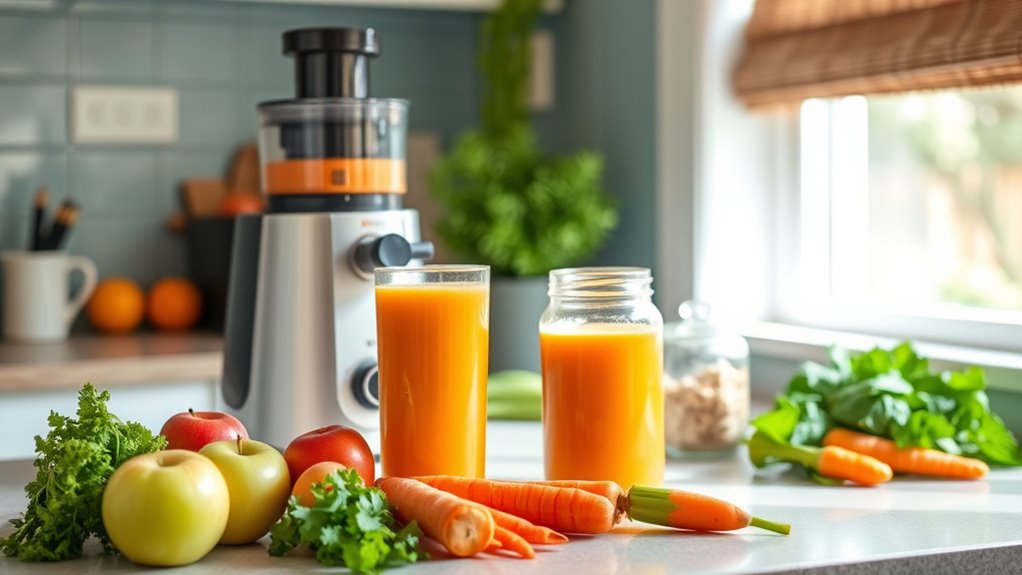
Ever wondered how to enjoy fresh, nutritious juices without breaking the bank? Juicing can be a cost-effective way to boost your health, but it requires some savvy strategies to keep expenses low. One of the best ways to save money is by integrating meal prep into your routine. Planning your juices ahead of time allows you to buy ingredients in bulk, reducing waste and taking advantage of discounts. When you prepare multiple servings at once, you minimize trips to the store and avoid impulse purchases, which can add up quickly. Plus, meal prep helps you stay consistent with your juicing habit, ensuring you’re always stocked with fresh, homemade drinks.
Investing in the right kitchen gadgets can also make a significant difference in your budget. A good-quality juicer, for instance, might seem like a bigger upfront expense, but it pays off in the long run by lasting longer and extracting more juice from your produce. Look for versatile appliances, such as a slow juicer or a masticating juicer, that can handle a variety of ingredients efficiently. These gadgets often preserve more nutrients and yield more juice, meaning less waste and more value for your money. Additionally, consider buying a blender if you’re open to smoothies as an alternative; blenders are generally more affordable and can still provide a nutritious, juice-like experience.
Choosing versatile, high-quality gadgets like slow juicers and blenders enhances savings and nutrition.
Another cost-saving tip involves choosing ingredients wisely. Focus on seasonal fruits and vegetables, which are usually cheaper and fresher. Shopping at farmers’ markets or local produce stands can also save you money compared to grocery store prices. When buying in bulk, store produce properly—freezing excess fruits like berries or mangoes ensures you won’t waste them and can use them over time. Don’t overlook frozen fruits and vegetables, which are often less expensive than fresh and just as nutritious, especially when out of season. Incorporating these into your juicing routine helps you maintain variety without overspending.
Finally, be mindful of your consumption habits. Juicing daily is great, but it’s easy to get carried away and use more produce than necessary. Stick to simple recipes that maximize flavor without requiring numerous ingredients. By sticking to a budget-friendly shopping list and making your own juice at home, you cut out the costs associated with store-bought options and specialty juice bars. Over time, these small adjustments—meal prepping, choosing the right kitchen gadgets, selecting affordable produce—add up, making daily juicing both enjoyable and economical. Additionally, exploring beach destinations for relaxing getaways can provide a refreshing break and motivation to maintain your healthy habits.
Frequently Asked Questions
What Are the Best Affordable Fruits and Vegetables for Juicing?
When choosing affordable fruits and vegetables for juicing, focus on seasonal produce from local markets. These are often cheaper and fresher, giving you better flavor and nutrients. Look for affordable options like carrots, apples, cucumbers, and leafy greens that are in season. By shopping locally and seasonally, you can save money while enjoying a variety of healthy ingredients. This approach makes juicing both budget-friendly and delicious.
How Can I Store Fresh Juice to Extend Its Shelf Life?
To extend your fresh juice’s shelf life, focus on proper refrigeration techniques. Store your juice in airtight containers to prevent oxidation and contamination. Fill the containers to the brim to minimize air exposure, and keep them refrigerated at or below 40°F. For best results, consume the juice within 24-48 hours. This way, you preserve nutrients, flavor, and freshness while saving money by reducing waste.
Are There Cost-Effective Alternatives to Premium Juicing Equipment?
Imagine transforming your kitchen into a high-tech juicing lab with shiny, expensive gadgets—only to realize your budget’s tighter than your juicer’s seal. Instead, opt for homemade juicers or DIY juicing methods that save you a fortune. You don’t need premium equipment; a trusty blender or a simple manual press does the trick. Save money, get creative, and enjoy fresh juice without breaking the bank!
How Often Should I Juice to Maximize Health Benefits on a Budget?
To maximize health benefits on a budget, you should aim for a moderate juicing frequency, like 3 to 5 times a week. This approach helps you optimize nutrients without overspending or wasting produce. Consistency is key, so plan your juicing schedule around your lifestyle. By balancing juicing frequency with your budget, you support your health goals while keeping costs manageable, making your juice routine both effective and affordable.
Can Frozen Produce Be as Nutritious as Fresh for Juicing?
Frozen produce benefits often include preserved nutrients, making them a great option for juicing. While fresh produce may have slightly higher fresh vs frozen nutrients, freezing locks in most vitamins and antioxidants, ensuring you still get good health benefits. Plus, frozen fruits and vegetables tend to be more affordable and available year-round. So, don’t hesitate to use frozen produce, especially if it helps you save money while maintaining nutrition.
Conclusion
Remember, “A penny saved is a penny earned.” By planning your ingredients, buying in bulk, and using versatile produce, you can enjoy nutritious daily juices without breaking the bank. Embrace flexibility and get creative with seasonal fruits and veggies. Juicing on a budget isn’t just possible, it’s rewarding. Keep these tips in mind, and you’ll find that healthy habits become easier—and more enjoyable—when you make smart choices. Happy juicing!
